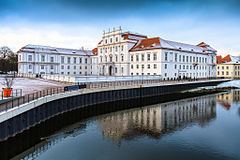Elevation 34 m (112 ft) Postal codes 16515 Population 41,577 (31 Dec 2008) Postal code 16515 | Time zone CET/CEST (UTC+1/+2) Dialling codes 03301 Local time Sunday 6:55 AM | |
 | ||
Weather 1°C, Wind N at 2 km/h, 98% Humidity University Brandenburg State Police Academy and College | ||
Germany oranienburg palace and its garden
Oranienburg is a town in Brandenburg, Germany. It is the capital of the district of Oberhavel.
Contents
- Germany oranienburg palace and its garden
- Map of Oranienburg Germany
- Geography
- Division of the town
- History
- International relations
- Public institutions
- References
Map of Oranienburg, Germany
Geography
Oranienburg is a town located on the banks of the Havel river, 35 km north of the centre of Berlin.
Division of the town
Oranienburg consists of 9 districts
History
Originally named Bötzow, the town of Oranienburg dates from the 12th century and was first mentioned in 1216. Margrave Albert the Bear (ruled 1157-1170) allegedly ordered the construction of a castle on the banks of the Havel. Around the castle stood a settlement of traders and craftsmen.
In 1646 Friedrich Wilhelm I of Brandenburg married Louise Henriette of Orange-Nassau (German: Oranien-Nassau). She was so attracted by the town of Bötzow that her husband presented the entire region to her. The princess ordered the construction of a new castle in the Dutch style and called it Oranienburg or Schloss Oranienburg. In 1653 the town of Bötzow was renamed Oranienburg.
Silvio Gesell, the founder of Freiwirtschaft ("free economy"), lived in Oranienburg between 1911 and 1915, publishing his magazine, Der Physiocrat. He returned to the town in 1927 and lived there until his death in 1930. The town remained a center of the "free economy" movement until the Nazi régime outlawed it in 1933, and many of Gesell's followers ended up as prisoners in the town's concentration camp.
The Oranienburg concentration camp (established in March 1933) was one of the first Nazi concentration camps. In 1936 the Sachsenhausen concentration camp on the outskirts of Oranienburg replaced it; there 200,000 people were interned over the 9 years that the Nazis operated it. The Nazis murdered about 22,000 people there before the liberation of the camp by the Soviet Red Army in 1945. Thereafter the site reopened in August 1945 as "Soviet Special Camp 7". A further 12,000 people (mostly Nazis not awaiting trial) died under the Soviets before the Special Camp closed in 1950. Their remains were not discovered until the 1990s.
Oranienburg became the center of Nazi Germany's nuclear-energy project. According to military historian Antony Beevor, Stalin's desire to acquire that facility motivated him to launch the Battle for Berlin of April-May 1945. It has been claimed that the pre-emptive destruction of these facilities by the USAAF Eighth Air Force on 15 March 1945 aimed to prevent them from falling into Soviet hands.
On 23 April 1945, during the Battle of Berlin, troops of the 1st Belorussian Front of the Red Army captured Oranienburg.
As of 2014, almost 70 years after World War II, about 300 pieces of unexploded ordnance (UXO) remain below the pavement. Oranienburg is the only city in Germany which pursues a systematic search for UXO based on postwar aerial photos and magnetic or radar underground measurements for metal. It is estimated that the search and safe detonation will continue throughout the rest of the century. In one case 12,000 residents had to be evacuated. The federal government does not finance the removal of foreign UXO.
International relations
Oranienburg is twinned with:
Public institutions
The Zehlendorf transmission facility, a large facility for broadcasting in longwave, medium wave and FM-range, is located near Oranienburg, at Zehlendorf.
